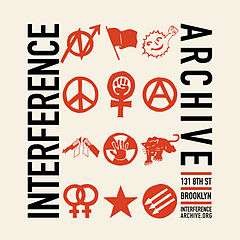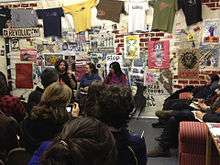Interference Archive
 | |
| Country | United States |
|---|---|
| Type | Archive |
| Established | 2011 |
| Location | Brooklyn, New York |
| Coordinates | 40°40′21″N 73°59′29″W / 40.672487°N 73.991402°WCoordinates: 40°40′21″N 73°59′29″W / 40.672487°N 73.991402°W |
| Website | http://interferencearchive.org/ |
Interference Archive is a volunteer-run library, gallery, and archive of historical materials related to social and political activism and movements. It is located in the Gowanus neighborhood of Brooklyn, New York City.
History
Interference Archive began as the personal collection of Josh MacPhee and Dara Greenwald, activists who told the New York Times that they had filled their home with so much "social movement memorabilia ... Ph.D. students would visit to conduct research."[1][2][3] The idea to turn it into a public resource began in 2008 when the couple was asked to curate an exhibition at the Exit Art gallery in Manhattan. Using the title "Signs of Change," it showcased cultural artifacts produced by those engaged with groups organizing to foment change.[1][4][5] The show and research they did in preparation for it is reflected in the Interference Archive mission statement which begins, "Interference Archive explores the relationship between cultural production and social movements."[6] MacPhee and Greenwald also point to archives and libraries of similar scope and purpose as inspiration, including another Brooklyn-based organization, the Lesbian Herstory Archives.[7]
In 2010 MacPhee and Greenwald moved their collection to its current home in a warehouse in Gowanus, in collaboration with activists and artists Molly Fair and Kevin Caplicki. Greenwald named it Interference Archive to capture "the idea that the collection causes static, or interference, in institutional archives and in the larger society."[4][7][8] It opened its doors to the public in December 2011 with a punk and feminism themed exhibition in tribute to Greenwald, who had been struggling with endometrial cancer and died the following month.[1][4]
Interference Archive has broadened its activities significantly since opening, operating as a library and community space and hosting regular talks, art exhibitions, performances, workshops, and other events. As of 2014 it operates on a yearly budget of less than $25,000, supported primarily by donations from a community of financial sustainers.[1]
Collection
The archive is housed in a 725-square-foot (67.4 m2) warehouse space, filled to the ceiling.[1] The collection includes a number of different kinds of media artifacts which provide information and illustration about the histories of radical political movements around the world, with 40% of the archive coming from outside the United States.[7] Among the materials are posters, fliers, pamphlets, zines, stickers, T-shirts, books, graphic novels, newspapers, games, videos, leaflets, buttons, audio recordings, and other ephemera.[1][4][6] The topics it covers includes ACT-UP, Occupy Wall Street, Arab Spring, Code Pink, Pink Bloque, Rock for Choice, Latin American art, nature, ecology, feminism, punk rock, criminal justice, prison reform, apartheid, anti-nuclear movement, squatting, anarchist bookfairs, May 1968 events in France, and Dutch anti-fur activism.[4][7][9]
The owners and volunteers take a pointedly nontraditional approach to archivism. In selection and acquisition, no priority is given to particular movements, media types, or well-known artists.[4] Instead, it positions itself as a commons where people can share what they have and benefit from what was donated by others.[4][7] Whereas most archives stress materials protection and preservation, the Interference Archive promotes access and use: "materials only have meaning when they're in circulation"[4] spreading ideas beyond their boxes and files.
Events

In addition to its primary purpose as an archive and library, Interference Archive also functions as a multipurpose community center and events space.[1][4] Past events have covered prison reform,[10][11] the Asian American movement in New York,[12][13] underground newspapers,[14] and the anti-nuclear movement.[15]
One exhibit in April 2013 featured "book blocs", home-made cardboard shields glued together by activists for use during college tuition protests.[16] The shields on display as well as others made during a workshop earlier in the month were confiscated as weapons by the New York Police Department the day before they were due to be used at Cooper Union in a protest against the school's decision to begin charging tuition.[16][17]
References
- 1 2 3 4 5 6 7 Lau, Maya (19 July 2013). "The Activism Files". The New York Times.
- ↑ Denda, Kayo; Vidal, Lucky (31 May 2013). "Academic Libraries Advancing Transnational Feminism". IFLA WLIC 2013.
- ↑ Lakakis, Eleftheria (21 October 2014). ""We're Doing It Slow" -- Community Archives as Protest Spaces". Re.Framing Activism Blog.
- 1 2 3 4 5 6 7 8 9 Bader, Eleanor J. (4 October 2012). "In the Archives of Interference". The Brooklyn Rail: Critical Perspectives on Arts, Politics, and Culture.
- ↑ Vartanian, Hrag. "Exit Art's "Signs of Change: Social Movement Cultures 1960s to Now" Exhibition". Flickr.
- 1 2 "Our Mission". Interference Archive.
- 1 2 3 4 5 "The Interference Archive Documents Radical History". Library Juice. 10 April 2012.
- ↑ Hong, Oliver. "Interference Archive: Volunteer-run library dedicated to exploring five decades of activism history". Atlas Obscura.
- ↑ Davis, Ben (24 June 2013). "Alternatives [VIDEO]: The Interference Archive in Gowanus". Blouin Artinfo.
- ↑ McCallister, Jared (14 September 2014). "Distorted and inaccurate mainstream media coverage marred the West Indian American Day Carnival parade – and others also took aim at the Labor Day festival". Daily News.
- ↑ Steinhauer, Jillian (16 October 2014). "Your Concise Guide to Gowanus Open Studios 2014". Hyperallergic.
- ↑ Havis, Richard James (9 February 2014). "New York exhibition celebrates awakening of Asian-American identity in the 1970s". South China Morning Post.
- ↑ "Interference Archive Exhibition and Open House". Library Manifesto. 14 January 2014.
- ↑ Trofimenkov, Mikhail (26 July 2013). "Camera for the Faith [Google Translate]". Kommersant (in Russian).
- ↑ "Interference Archive, Open House, Screening and Exhibition: "RadioActivity!: Films from the Anti-nuclear Movement in Japan"". New York City Archivists. 11 October 2012.
- 1 2 Barliant, Claire (1 May 2013). "Reach for the Book -- It Is a Weapon". The New Yorker.
- ↑ Lau, Maya (30 April 2013). "In Defense of Education, Books as Armor". The 6th Floor. The New York Times Magazine.
Further reading
- Edward Helmore, "Collecting the art of protest at Brooklyn's Interference Archive," The Guardian (October 14, 2015)
- "British Designer Bella Freud Reveals Her Beauty Must-Haves and the “Rare Jewel” of London: The Inspirational Jaunt: Interference Archive," Style (January 29, 2015)